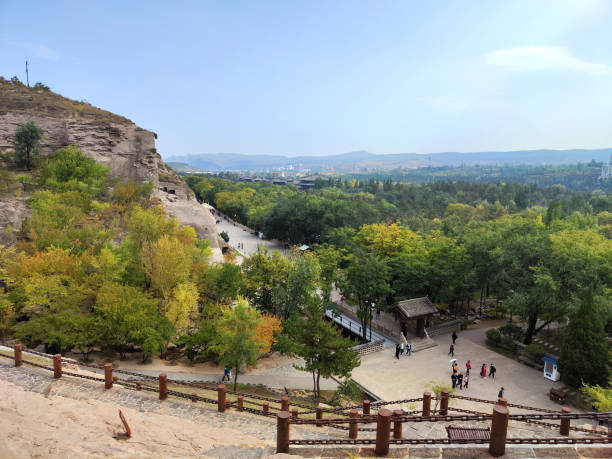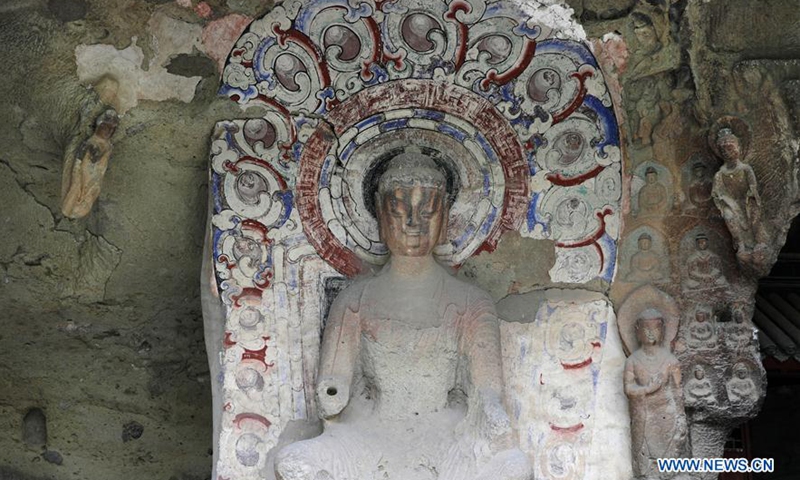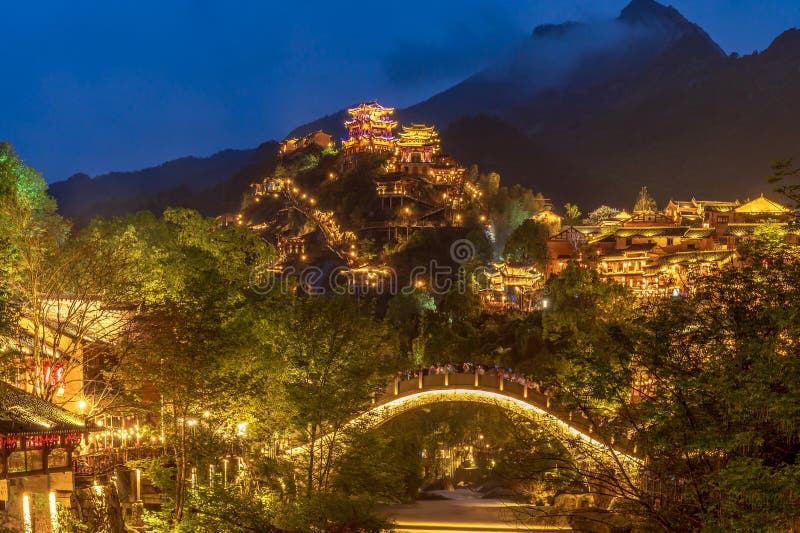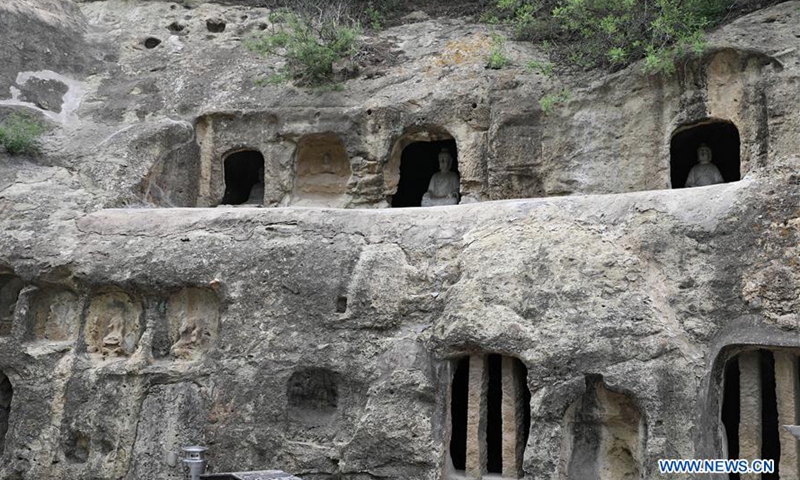Experience Serenity and History at Wanfotang Grottoes in Yixian

An Essential Guide to Visiting Wanfotang_Grottoes_Yixian
Nestled in the serene landscapes of Yixian County, Liaoning Province, the Wanfotang Grottoes stand as a testament to China’s rich Buddhist heritage and artistic mastery. This extraordinary site, often overshadowed by more famous attractions, is a hidden gem that beckons the intrepid traveler seeking both history and tranquility. Dating back to the Northern Wei Dynasty over 1,500 years ago, the grottoes house a remarkable collection of sculptures and carvings that reflect the spiritual fervor and artistic innovation of their time.
As you approach the grottoes, the stunning natural backdrop of the Daling River enhances the allure of this historical site. The intricate sculptures, including the famous “Maitreya Buddha” and the mesmerizing “Thousand-Handed Avalokiteshvara,” captivate visitors with their intricate details and spiritual significance. Each cave tells a unique story, revealing the artistic evolution through the centuries while allowing a glimpse into the religious practices of ancient China.
Whether you are a history buff, an art enthusiast, or simply seeking a peaceful escape from the bustling modern world, the Wanfotang Grottoes offer a unique experience that combines natural beauty, architectural splendor, and cultural depth. Prepare to be enchanted by the echoes of the past as you walk through this sacred space, where each carved figure stands as a silent witness to the passage of time.
In This Guide
- An Essential Guide to Visiting Wanfotang_Grottoes_Yixian
- The Rich History and Legends of Wanfotang_Grottoes_Yixian
- Main Highlights: What You Absolutely Can’t Miss
- Planning Your Visit: A Practical Guide
- Tickets: Prices, Booking, and Tips
- How to Get There: A Complete Transportation Guide
- Local Cuisine and Accommodation Nearby
- Frequently Asked Questions
- Final Thoughts on Your Trip
The Rich History and Legends of Wanfotang_Grottoes_Yixian
Nestled in the tranquil surroundings of Yixian County in Liaoning Province, the Wanfotang Grottoes are a treasure trove of history that beckons travelers intrigued by ancient cultures and architectural marvels. Established during the Northern Wei Dynasty, around 499 AD, this complex of caves represents one of the earliest and largest grottoes in Northeast China. It is a site rich in history, artistry, and legends that span over a millennium.
The creation of the Wanfotang Grottoes is attributed to the esteemed monk Tan Yao, who was also responsible for the famous Yungang and Longmen Grottoes. Commissioned by General Yuan Jing, the caves were originally carved out to honor the Yellow Emperor and to bring blessings to the local populace. This historical background not only highlights the religious significance of the site but also its role as a cultural hub during a transformative period in Chinese history.
The grottoes are divided into two main sections: the East and West areas. The West area is particularly noteworthy, featuring nine primary caves adorned with intricate carvings and sculptures, including the majestic “Crossed-legged Maitreya” statue, which stands at a commanding height of 3.2 meters. This statue, with its serene expression and graceful form, epitomizes the Northern Wei sculptural style and remains one of the largest of its kind in the region. The artistry is further enhanced by the inscriptions on the walls, including the revered “Yuan Jing Stele,” which not only serves as a work of art but also as a critical piece of historical documentation.
In contrast, the East area, while housing fewer sculptures, is home to the striking “Thousand-Handed and Thousand-Eyed Avalokiteshvara,” a testament to the Buddhist influence that permeated the region during the time. This exquisite figure is characterized by its numerous arms, each adorned with an eye, symbolizing the deity’s ability to see and assist all beings in need.
Over the centuries, the Wanfotang Grottoes have faced significant challenges, including natural erosion and human neglect. However, restoration efforts have allowed much of the original beauty and cultural significance to be preserved. In 1988, the site was designated a national key cultural relic protection unit, affirming its importance in China’s rich historical tapestry.
Visiting the Wanfotang Grottoes offers more than just a glimpse into ancient artistry; it immerses travelers in the legends and spirituality of a bygone era. As you wander through the caves, the echoes of the past resonate through the intricately carved walls, where each figure and inscription tells a story of devotion, artistry, and cultural exchange.
The surrounding landscape enhances the experience, with the Daling River flowing nearby, creating a serene backdrop that complements the grottoes’ historical significance. This harmonious blend of human ingenuity and natural beauty makes the Wanfotang Grottoes a must-visit destination for those seeking to explore the depths of China’s ancient heritage.
Whether you are an avid historian, a spiritual seeker, or simply a traveler in search of breathtaking vistas, the Wanfotang Grottoes promise an unforgettable journey through time, where legends linger and history whispers.

Wanfotang_Grottoes_Yixian.
Main Highlights: What You Absolutely Can’t Miss
Nestled along the banks of the Daling River in Yixian County, the Wanfotang Grottoes present an awe-inspiring glimpse into China’s rich Buddhist heritage. These ancient stone caves, dating back to the Northern Wei dynasty, are not just historical relics but a testament to the artistry and devotion of their creators. Here are the must-see highlights that you absolutely cannot miss during your visit.
The Magnificent Grottoes
- Western District Grottoes
- Main Cave (Cave One): This is the largest and most splendid cave at Wanfotang, showcasing the typical Northern Wei architectural style. The cave features intricate carvings and remains of colorful murals that have withstood the test of time. Don’t miss the central stone pillar adorned with multiple Buddha figures, a key highlight reflecting the artistic prowess of the era.
- The Iconic “Cross-Legged Maitreya Buddha” (Cave Six): Standing at 3.2 meters, this statue is the largest and one of the earliest representations of Maitreya Buddha in Northeast China. Its serene expression and elegant form are captivating, making it a focal point for visitors.
-
Inscription of General Yuan Jing: The inscription stone located in Cave Five is a significant cultural artifact, noted for its exquisite calligraphy. It serves as an important historical document, countering claims about the territorial integrity of China during the Northern Wei period.
-
Eastern District Grottoes
- Thousand-Handed, Thousand-Eyed Avalokiteshvara (Cave Three): This stunning depiction of the bodhisattva is a must-see. The intricate details of the 46 arms and eyes, symbolizing compassion and the ability to see the suffering of all beings, make this figure an extraordinary artistic achievement.
- Small Laughing Buddha: Tucked away in a corner, this small yet charming statue is sure to bring a smile to your face. It embodies a playful spirit and is easy to overlook, making it a delightful surprise for those who take the time to explore.
Scenic Views and Natural Beauty
The Wanfotang Grottoes are not just about the caves; they are also a part of a breathtaking landscape. The setting on the riverbank allows for stunning views of the surrounding countryside, including lush fields and rolling hills. Take a moment to soak in the tranquility of the area, which offers a peaceful retreat from the hustle and bustle of modern life.
Tips for Your Visit
- Timing: Plan your visit during early morning or late afternoon to avoid crowds and enjoy the soft lighting for photography.
- Duration: Allocate about 1.5 to 2 hours to fully appreciate the grottoes and the surrounding natural beauty.
- Accessibility: The site is accessible by car, and it’s advisable to book a local driver for convenience. Expect a round trip fare of around 80 RMB from Yixian County.
- Photography: Bring a good camera to capture the intricate details of the carvings and the beautiful scenery. Ensure your batteries are charged!
Conclusion
The Wanfotang Grottoes are a hidden gem in Northeast China, offering a unique blend of history, art, and natural beauty. Whether you are a history enthusiast, an art lover, or simply seeking a peaceful place to reflect, these grottoes promise an unforgettable experience. Don’t miss the chance to explore this remarkable site that tells the story of a bygone era through its stunning stone carvings and serene landscapes.

Wanfotang_Grottoes_Yixian.
Planning Your Visit: A Practical Guide
Visiting the Wanfotang Grottoes in Yixian is a journey into the rich tapestry of China’s Buddhist heritage, set against the scenic backdrop of Liaoning Province. As you plan your visit, here are crucial details to ensure a smooth and enriching experience.
Getting There
The Wanfotang Grottoes are located approximately 9 kilometers northwest of Yixian County, along the scenic banks of the Daling River. The easiest way to reach the grottoes is by private car or taxi. If you’re traveling from Jinzhou, you can take a bus or train to Yixian and then hire a taxi or local transportation to the site.
- From Jinzhou:
- Take a high-speed train to Jinzhou South Station, then board bus route 205 to Jinzhou Station. From there, you can catch a K-series train or a long-distance bus to Yixian.
-
Expect a travel time of about 45 minutes to an hour from Jinzhou to Yixian.
-
Local Transport:
- In Yixian, taxis and ride-hailing services are readily available. The fare to the grottoes is generally around 10-20 CNY. Alternatively, you can arrange a private car for about 80 CNY round trip, which allows flexibility in your visit.
Opening Hours and Admission
The grottoes are open daily, with hours typically from 8:30 AM to 3:30 PM, with the last entry at 3:00 PM. A nighttime viewing option is also available from 5:30 PM to 9:30 PM. Admission fees are generally modest, so be sure to check current rates on reliable travel websites or at the entrance.
What to Expect
Wanfotang Grottoes are divided into two main areas: the Eastern and Western sections, featuring a total of around 20 caves adorned with over 430 statues. Here are some highlights:
- Western Section: This area is the pride of the grottoes, showcasing intricate carvings from the Northern Wei Dynasty (499 AD). Notable features include:
- The Grand Maitreya: A towering statue at 3.2 meters, this figure embodies the serene and benevolent essence of Maitreya, a significant figure in Buddhist belief.
-
Sculptures: Look out for the famed Yuanjing Stele, which holds considerable historical significance and showcases exquisite calligraphy.
-
Eastern Section: Though less preserved, this section features the Thousand-Handed Avalokitesvara, a striking image of compassion, with 46 hands, each holding an eye.
Recommended Duration
Plan to spend about 1.5 to 2 hours exploring the grottoes. This duration allows ample time to appreciate the artistry of the caves and the spiritual atmosphere.
Tips for Your Visit
-
What to Bring: Comfortable walking shoes are a must, as the site involves some walking. Bring a camera to capture the stunning sculptures and landscapes, but remember to respect the religious nature of the site by refraining from using flash photography.
-
Local Cuisine: After your visit, do not miss out on trying local specialties in Yixian. Look for traditional Liaoning dishes and street food like Wuhua Yitao, a hearty breakfast platter unique to the region.
-
Cultural Sensitivity: As this is a significant historical and religious site, observe local customs, refrain from loud conversations, and avoid bringing in food and drinks.
Nearby Attractions
Extend your trip by visiting nearby historical sites, such as:
– Fengguo Temple: A renowned ancient temple showcasing exquisite architecture and décor.
– Guangsheng Temple Tower: This ancient pagoda presents an excellent photo opportunity and insight into the region’s history.
Conclusion
The Wanfotang Grottoes not only offer a glimpse into the artistic achievements of ancient China but also provide a tranquil space for reflection and appreciation of Buddhist culture. With this guide, you are well-equipped to embark on a memorable journey to one of Northeast China’s hidden gems. Enjoy your visit!

Wanfotang_Grottoes_Yixian.
Tickets: Prices, Booking, and Tips
Visiting the Wanfotang Grottoes in Yixian is a unique experience that combines ancient artistry with stunning natural landscapes. Here’s everything you need to know about ticket prices, booking options, and some handy tips to make the most of your visit.
Ticket Information
- General Admission: The entry fee to the Wanfotang Grottoes is approximately CNY 30 (about USD 4.50). Prices can vary slightly depending on the season and any special events.
- Discounts: There may be discounts available for students, seniors, or groups, so it’s worth asking at the ticket counter about any applicable rates.
- Opening Hours: The grottoes are open daily from 08:00 AM to 04:30 PM. Last entry is at 04:00 PM, so make sure to arrive with enough time to explore.
Booking Tickets
- Online Reservations: While tickets can be purchased on-site, consider booking in advance through platforms like Trip.com or local travel agencies to avoid long queues, especially during peak tourist seasons.
- On-Site Purchase: Tickets can also be bought at the entrance. However, be aware that during weekends and holidays, the site can get crowded, so arriving early is advisable.
Tips for Your Visit
-
Plan Your Stay: Allocate about 1.5 to 2 hours to thoroughly explore the grottoes and appreciate the intricate carvings and stunning views of the Daling River that frame the site.
-
Transportation: If you’re traveling from downtown Yixian, consider hiring a taxi or booking a car to take you to the grottoes. It’s about a 20-kilometer drive, and fares are usually around CNY 80 for a round trip.
-
What to Bring: Wear comfortable walking shoes as the terrain can be uneven. A camera is a must for capturing the breathtaking sculptures, especially the famous “thousand-hand and thousand-eye Guanyin” statue.
-
Respect the Site: As a place of historical and cultural significance, be mindful of the rules. Pets and large bags are typically not allowed inside the grottoes, and visitors should refrain from any religious practices that are not part of the site’s offerings.
-
Visit Nearby Attractions: After exploring the grottoes, consider visiting nearby sites like the Guosheng Temple or the historic Guangshengtai Pagoda for a fuller experience of Yixian’s rich cultural landscape.
With its rich history and stunning artistry, the Wanfotang Grottoes is a must-see gem in northeastern China. By planning ahead and following these tips, you’ll ensure a memorable visit filled with awe and inspiration.
How to Get There: A Complete Transportation Guide
Reaching the Wanfotang Grottoes in Yixian, a remarkable historical site nestled in the scenic landscapes of Liaoning Province, is an adventure that offers a glimpse into China’s rich cultural heritage. This guide provides all the essential transportation options to ensure your visit to this magnificent location is smooth and enjoyable.
By Air
The nearest major airport to Yixian is Jinzhou Airport (JNZ), located approximately 50 kilometers away. From international destinations, travelers may find it more convenient to fly into Shenyang Taoxian International Airport (SHE), which is about 170 kilometers from Yixian.
By Train
For those traveling by train, Jinzhou South Railway Station serves as a key transit point. High-speed trains connect Jinzhou with major cities like Beijing and Shenyang. Upon arriving at Jinzhou South, you can take a local bus or taxi to reach Yixian.
By Bus
Once in Jinzhou, you have two main options to get to Yixian:
1. Long-distance Bus: Head to the Jinzhou Bus Station, where you can catch a bus to Yixian. Buses run approximately every 15 minutes, with a journey time of about 1.5 hours. The fare is around 17 RMB.
2. K-series Train: Alternatively, you can take a K-series train from Jinzhou Station to Yixian. This option operates three times daily, with a travel time of roughly 45 minutes and a ticket price of about 11 RMB.
Local Transportation in Yixian
Once you arrive in Yixian, various local transportation methods are available:
– Taxis: The starting fare for taxis in Yixian is about 5 RMB, and most rides within the city typically cost less than 10 RMB.
– Bicycle Rentals: For the more adventurous, consider renting a bicycle to explore the town and its surroundings at your own pace.
Getting to Wanfotang Grottoes
To reach the Wanfotang Grottoes from Yixian city center:
– Local Bus: From the Yixian Bus Station, take the Northwest Ring Line minibus which heads to the grottoes. Be sure to check the schedule for return times, as buses may run every 30-45 minutes.
– Car Hire: For the most convenience, consider hiring a private car or taxi. The grottoes are about 20 kilometers from Yixian, and the round-trip fare typically costs around 80 RMB. The driver can wait for you while you explore the site.
Tips for a Smooth Journey
- Language: While many locals may not speak English, having the name of your destination written in Chinese can help facilitate communication.
- Contact Information: It can be useful to have the contact details of your driver or a local guide, especially for arranging transportation back to Yixian.
- Timing: The Wanfotang Grottoes are open from 8:30 AM to 3:30 PM (last entry at 3:00 PM), so plan your visit accordingly to maximize your time exploring this breathtaking site.
With this transportation guide, you are well-equipped to embark on your journey to the Wanfotang Grottoes in Yixian. Enjoy your adventure exploring the historical treasures of Liaoning Province!

Wanfotang_Grottoes_Yixian.
Local Cuisine and Accommodation Nearby
Exploring the Wanfotang Grottoes in Yixian is not just about marveling at the ancient stone carvings and the stunning landscapes; it’s also an opportunity to savor the local cuisine and find comfortable accommodations nearby. Here’s a guide to help you enjoy both during your visit.
Local Cuisine
Yixian offers a delightful variety of local dishes, drawing influences from the rich culinary traditions of Northeast China. While visiting the Wanfotang Grottoes, don’t miss the chance to indulge in some of these specialties:
-
Wuhua Yita (五花一套): Often regarded as the quintessential Yixian breakfast, this dish consists of a medley of steamed goodies, including chicken egg cake, pig’s blood, meat, white meatballs, and silky water tofu, all served with a bowl of glutinous rice and sour cabbage. The water tofu, in particular, is a must-try; it’s so smooth that it glides down your throat effortlessly.
-
Liu Er Shui Dofu (刘二水豆腐): This local tofu brand is known for its freshness and unique preparation methods. Enjoy it paired with a savory meat sauce or simply on its own to appreciate its delicate flavor.
-
Zhuangyuanqiao Guoqiao Mixian (状元桥过桥米线): A popular noodle dish that features rice noodles served in a fragrant broth with a variety of toppings. It’s a favorite among locals and a great way to warm up after a long day of exploring.
-
Various Street Snacks: As you stroll through Yixian, keep an eye out for street vendors selling grilled skewers, dumplings, and traditional pastries. These snacks are perfect for a quick bite between visits to the grottoes.
Accommodations Nearby
After a day of exploring the historic Wanfotang Grottoes, you’ll want a cozy place to rest. Here are some accommodation options that offer comfort and convenience:
-
Yixian Hotel (义县酒店): Located in the heart of Yixian, this hotel provides modern amenities and easy access to local attractions. With comfortable rooms and a restaurant serving local dishes, it’s an excellent choice for travelers.
-
An Tai Men Inn (安泰门客栈): A charming guesthouse offering a warm atmosphere and personalized service. This inn is favored by those looking for a homely touch during their stay. The owners often share insights about the local culture and cuisine.
-
Jinzhou International Hotel (锦州国际酒店): If you’re looking for something a bit more upscale, this hotel in nearby Jinzhou offers luxurious accommodations, a fitness center, and fine dining options. It’s a short drive from the grottoes and provides a great base for further explorations in the region.
-
Homestays: For a more immersive experience, consider staying at a local homestay. This option allows you to connect with local families, learn about their daily lives, and enjoy home-cooked meals.
Whether you’re indulging in delicious local dishes or resting in comfortable accommodations, your visit to Wanfotang Grottoes in Yixian promises to be a memorable adventure filled with cultural richness and culinary delights.

Wanfotang_Grottoes_Yixian.
Frequently Asked Questions
Frequently Asked Questions about Wanfotang Grottoes, Yixian
1. Where are the Wanfotang Grottoes located?
The Wanfotang Grottoes are situated in Wanfotang Village, on the northern bank of the Daling River, approximately 9 kilometers northwest of Yixian County in Jinzhou, Liaoning Province, China.
2. What are the opening hours for the Wanfotang Grottoes?
The grottoes are open daily from 8:00 AM to 4:30 PM. Please note that ticket sales close at 4:00 PM, so plan your visit accordingly!
3. How much is the admission fee?
While specific pricing can vary, tickets generally fall within a reasonable range. Be sure to check local listings or ticketing platforms for the most accurate and updated prices before your visit.
4. How long should I plan to spend at the grottoes?
Most visitors spend about 1.5 to 2 hours exploring the Wanfotang Grottoes. This allows ample time to appreciate the intricate carvings and the stunning natural backdrop of the site.
5. Are there any restrictions on what I can bring into the grottoes?
Yes, pets are not allowed on the premises, and visitors are prohibited from bringing in candles or engaging in any religious activities within the grounds.
6. What are the highlights of the Wanfotang Grottoes?
The grottoes feature a remarkable collection of Buddhist sculptures, including the iconic “Maitreya Buddha” and the “Thousand-Handed Avalokiteshvara.” The site is renowned for its historical significance and stunning artistry, representing a treasure trove of North Wei Buddhist art.
7. How can I get to the Wanfotang Grottoes?
If you’re traveling from Jinzhou, the most convenient method is to hire a car or take a taxi. Alternatively, you can take a local bus to Yixian and then catch a taxi or a mini-bus to the grottoes. The distance from Yixian to the grottoes is roughly 20 kilometers.
8. Are there any nearby attractions worth visiting?
Absolutely! In addition to the Wanfotang Grottoes, the area is home to other notable sites such as the Gongsheng Temple and the Zhongde Paleontological Museum. Each offers a unique glimpse into the rich history and culture of the region, making for a fulfilling day of exploration.
Final Thoughts on Your Trip
As your journey through the Wanfotang Grottoes comes to a close, take a moment to reflect on the rich tapestry of history and artistry that envelops this remarkable site. Carved from the cliffs over 1,500 years ago, these majestic grottoes stand as a testament to the ingenuity and spiritual devotion of the Northern Wei Dynasty.
While the intricate sculptures—like the serene Maitreya Buddha and the awe-inspiring Thousand-Handed Avalokiteshvara—tell stories of ancient beliefs and artistic evolution, the breathtaking natural surroundings invoke a sense of peace and connection to the past. Walking through the grottoes, you’ll not only witness the remnants of a glorious era but also feel the whispers of time that resonate within these stone walls.
As you leave Wanfotang, carry with you the stories, the beauty, and the tranquility of this hidden gem in Liaoning Province. Whether it’s the gentle flow of the Daling River or the intricate details of the carvings that linger in your mind, let this experience inspire your future travels. Seek out the quieter places where history and nature converge, and remember that sometimes the most profound adventures are found off the beaten path. Safe travels on your journey ahead!